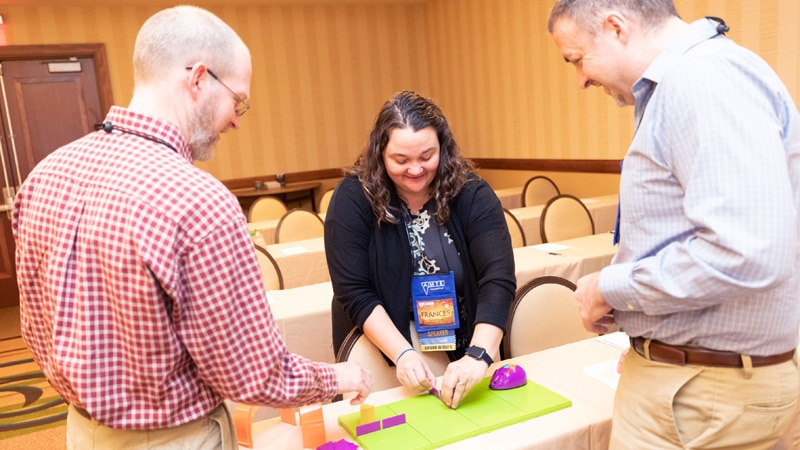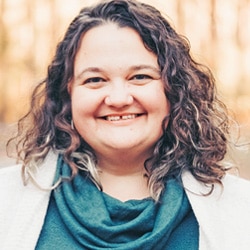
Frances Harper presents preliminary robotics work at the Association of Mathematics Teacher Educators conference in February 2020.
Frances Harper first tapped into the programs and services available through the Office of Research and Engagement at a new faculty orientation event in 2017. Three years later, that early connection has paid off—literally—with a recent $1 million grant from the National Science Foundation’s Computer Science for All program.
 Harper, an assistant professor of STEM education with a focus on mathematics education, collaborated with Lori Caudle and Margaret Quinn, both assistant professors in the Department of Child and Family Studies, as well as Amir Sadovnik, assistant professor in the Department of Electrical Engineering and Computer Science, on the project, “Culturally Relevant Robotics: A Family and Teacher Partnership (CRRAFT Partnership) for Computational Thinking in Early Childhood.”
Harper, an assistant professor of STEM education with a focus on mathematics education, collaborated with Lori Caudle and Margaret Quinn, both assistant professors in the Department of Child and Family Studies, as well as Amir Sadovnik, assistant professor in the Department of Electrical Engineering and Computer Science, on the project, “Culturally Relevant Robotics: A Family and Teacher Partnership (CRRAFT Partnership) for Computational Thinking in Early Childhood.”
The team had already compiled a rough draft, outline, and timeline by the time they reached out to Diana Moyer, a research development manager in ORE. “Diana’s personalized, one-on-one support for that proposal was most helpful,” said Harper. “Her deep understanding of NSF and feedback helped strengthen the research rationale and make it more understandable to a broader audience.”
The three-year project will work with teachers and families of children at two Knox County preschools, to introduce a culturally relevant robotics program that integrates the support of caregivers. By developing a culturally relevant robotics program that supplements the school curriculum, Harper hopes to investigate the impact of the program on Black and Latinx students’ development of computational thinking and their sense of belonging in computer science.
In addition to her successful NSF grant, Harper also participated in the NSF CAREER Proposal Writing Institute that Moyer leads each summer. She was one of 12 participants who attended five bi-weekly sessions focused on this opportunity for young faculty.
“I especially enjoyed the sessions with NSF-funded researchers and those who have served on NSF review panels,” Harper says. “I also benefitted from the feedback and reminders and the accountability built into the program.”
This past fall, Harper participated in a new program through ORE called Initiative for the Future, led by Alan Rutenberg, another of ORE’s research development managers. The program supports junior faculty in all fields, with a focus on prestigious national faculty awards and on interdisciplinary collaborations in fields of emerging significance. Seven faculty participated in sessions that focused on agency review panels and program officers, approaches to foundation funding, and long-term planning for individual research agendas.
“The most valuable aspect of Initiative for the Future was the exposure to new opportunities, such as the Fulbright program. I learned about opportunities for STEM education,” said Harper. “For example, the University of Edmonton has a strong STEM education program.”
Harper encourages her colleagues to take advantage of ORE’s various research development services—the earlier, the better.
“Sometimes it can seem so overwhelming with so many opportunities,” she said. “Pick a couple with different focuses. Learn about different kinds of opportunities. Think about a career-long trajectory. For me, that might be pursuing a Fulbright at associate professor level.”